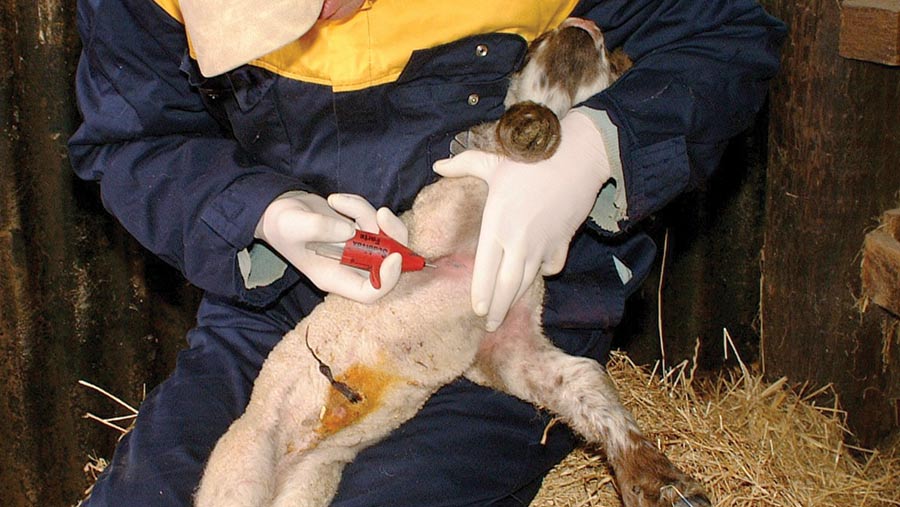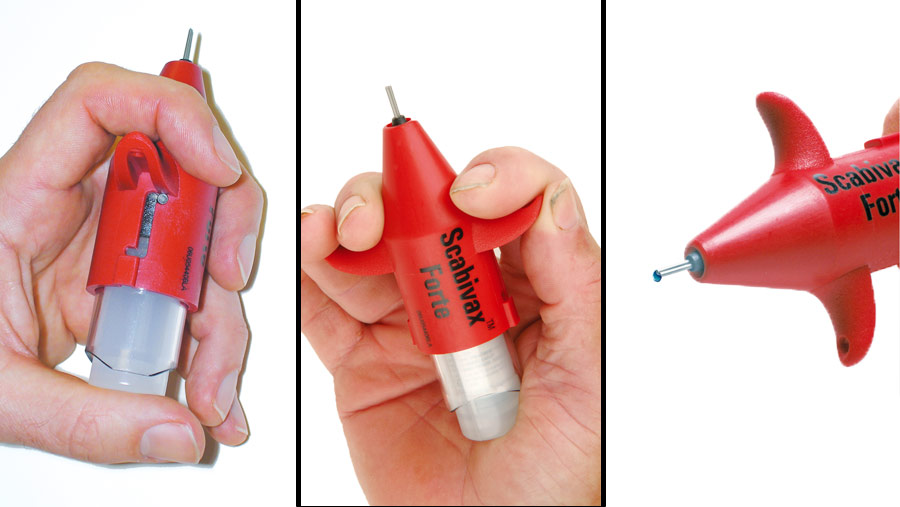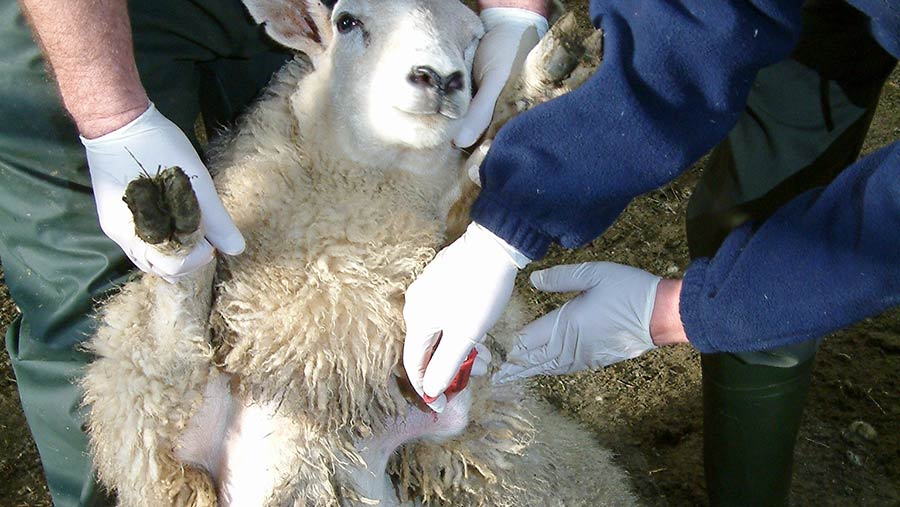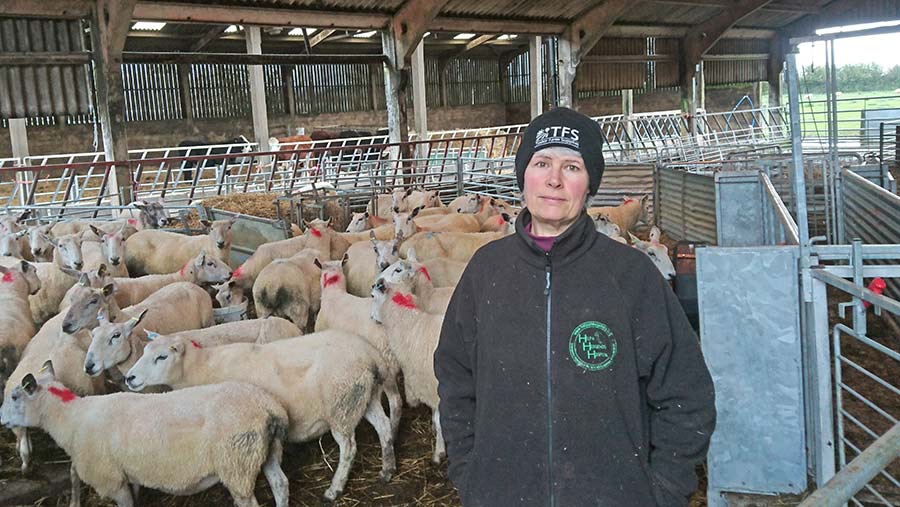Video: How to use orf vaccine correctly on sheep

About one in five lambs – 900,000 – are affected by the highly contagious orf virus in England’s sheep flock each year according to MSD Animal Health.
Added to that figure, the virus, which causes scabs and blistering at the site of infection, is prevalent throughout the wider UK flock.
See also: Tips on tackling mastitis in sheep
The disease often occurs around the lamb’s mouth, reducing its ability to feed and causing economic costs to mount.
Estimates suggest financial costs associated with orf range from £1.06 a lamb to as much as £14.03 a lamb.
But, despite the significance of the disease, many farmers are failing to protect flocks – a survey of 570 UK sheep farmers carried out by the University of Nottingham last autumn (2018) revealed the orf vaccine wasn’t being used effectively.
Responses showed 36% of farms were using the vaccine. But only a quarter of farmers (27%) were administering it correctly – under the front leg in an area of bare skin called the axilla.
More than a third (37%) said they used the vaccine up to a week after opening the vial, yet its shelf-life is just eight hours. This is because it is a live vaccine and its efficacy diminishes quickly once the vial is opened.
Because it is a live vaccine and contagious to humans, it is vital to wear protective gloves. However, only 53% of farmers said they used gloves when vaccinating sheep and only 31% washed their hands just before and immediately after vaccination.
One in three farmers also used the vaccine on ewes too close to housing and lambing time. The product should not be used within seven weeks of lambing to allow immunity to build up.
Allowing a minimum seven-week period also prevents any infected scabs from entering the lambing shed.
One of the survey organisers, Wendela Wapenaar from the School of Veterinary Medicine and Science at the university, said the results showed further practical advice was needed.
“We want to be able to help farmers use the vaccine properly and address any misunderstandings about best practice.
“It is important that the vaccine is administered according to instructions, which means via a scratch to the skin under the front leg using a proprietary applicator,” says Dr Wapenaar.
MSD Animal Health – manufacturer of the Scabivax Forte vaccine – has provided a list of dos and don’ts and a step-by-step to help farmers use the drug correctly.
It has also produced a video demonstrating how to administer the vaccine to ewes. Watch the video and read the guide below.
Do
- Wear appropriate rubber gloves
- Dispose of waste material by boiling, incineration or immersion in an appropriate disinfectant approved for use by the competent authorities
- Use within eight hours of opening the bottle
- Store in the fridge between 2c-8c
- Wash hands before and after vaccinating
- Sterilise the applicator in boiling water only for 10 minutes before and after use
Don’t
- Use the vaccine where orf is not present in a flock
- Use disinfectant on any parts of the applicator because it will inactivate the live virus vaccine
- Do not vaccinate ewes less than seven weeks before lambing
- Vaccinate in wet conditions because the vaccine will be washed off
- Vaccinate in housing or lambing sheds because the live vaccine can infect sheep
- Vaccinate animals on pasture to be grazed by untreated animals
- Allow animals to be marketed, slaughtered or shorn for seven weeks post-vaccination
How to vaccinate lambs against orf
The vaccine can be used to protect lambs from one day old and ewes, providing they are vaccinated seven to eight weeks before lambing.
The vaccine kit includes
- 50 dose bottle at 0.02ml/dose
- Vaccinator and sleeve for bottle

1. Preparing the applicator
- Place bottle into sleeve
- Lock the sleeve into the applicator by twisting
- Once locked, prime the applicator by pumping the sleeve about 10 times or until a droplet of vaccine emerges on the prong.
2. Delivering the vaccine
- One person should turn the sheep or lamb
- Second person should pull one of the animal’s front legs away from the body
- This exposes a small area of bare skin (axilla) between the leg and chest
- Place the applicator point on the axilla at about 45deg to the surface
- Then draw it across the skin to scratch it so there is a mark
- Do not break the skin to the extent that it bleeds
3. Cleaning
- During treatment, if the point is contaminated with muck or wool while treating the flock, clean it with cotton wool
- Do not use disinfectant – this will inactivate the live virus
- Dispose of the cotton wool in a secure container
- The material must then be thoroughly disinfected or burnt
- Dismantle the applicator completely and sterilise all parts in boiling water for 10 minutes
- Do not use disinfectant, which may leave a residue
- Dispose of unused vaccine carefully

4. Check the vaccine has taken
- Seven to 10 days after treating the flock examine the scratch site in a sample of animals
- A line of blisters or scabs shows the vaccine has worked. If not, contact the farm vet
Case Study
Beef and sheep farmer Pauhla Whitaker witnessed the impact of the orf virus five years ago when 30% of the year’s lamb crop contracted the disease.
Mrs Whitaker runs 390 breeding ewes on an organic set-up at Overtown Farm, Cranham, Gloucestershire, in partnership with her husband Martin.
Orf had been an underlying problem on the unit but it suddenly got worse in 2014, she explains.
Lambs showed the typical, scabby lesions around their mouths and stopped suckling because of the pain caused by the open wounds.
The highly contagious disease then spread to many of the ewes’ udders which meant lambs were being rejected and were going hungry.
Growth rates were hit and lambs took three weeks longer to finish, says Mrs Whitaker. The udder lesions caused an additional problem.
“The lesions allowed in bacteria, and mastitis levels almost doubled. Normally we would expect to replace 20-25 ewes because of mastitis issues. But in 2014 we culled 45 because of the disease.”

Pauhla Whitaker
Complications caused an additional problem with bacteria invading the orf lesions.
“We had to use antibiotics to tackle the infections which, on an organic farm have a much longer withdrawal period.
“Soil Association rules at the time insisted on a withdrawal period for the penicillin-based treatment three times longer than the recommended 31 days,” Mrs Whitaker says.
That period has since been reduced to double the conventional but it is still potentially a significant delay in marketing lambs, she points out.
With all of those problems and the increased labour time taken up, Mrs Whitaker decided to vaccinate the flock ahead of the next lambing.
After a discussion with the vet, Mrs Whitaker adopted a two-pronged vaccination programme for the flock. Ewes were scratched in the axilla under the foreleg at scanning to allow plenty of time for the live vaccine to “take”; usually seen as a line of scabs along the scratch site.
These scabs are infective so need time to form and drop off before housing (by seven weeks after vaccination) when they can infect lambs.
The second phase is to vaccinate all lambs at 72 hours old ahead of turnout. The programme has been a success and no ewes or lambs contracted the virus in the following years.
However, last year vaccination was interrupted by snow. The virus returned immediately to infect about 30 lambs.
“It was a wake-up call which has convinced us we need to keep vaccinating each year,” Mrs Whitaker adds.
